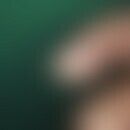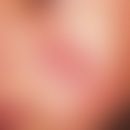Synonym(s)
HistoryThis section has been translated automatically.
Covisa and Berjarano 1927
DefinitionThis section has been translated automatically.
Chronic pyoderma reminiscent of syphilitic primary (chancre). The diagnosis has largely lost its significance in international literature.
You might also be interested in
PathogenThis section has been translated automatically.
LocalizationThis section has been translated automatically.
ClinicThis section has been translated automatically.
Derby, well demarcated, raised above the skin level, associated with vigorous inflammatory collateral edema, initially superficially eroded, later ulcerated, mies only slightly painful, crusted infiltrate. Regional moderately ductal swelling of the lymph nodes.
Differential diagnosisThis section has been translated automatically.
Ulcus durum: syphilis serology; lymphadenopathy.
Anthrax of the skin: extremely rare; acute event. At the site of inoculation, development of a less conspicuous red spot: increasing infiltration with then rapid formation of an inflammatory nodule or pustule; rapid spread, hemorrhagic blister; blackish necrosis with considerable collateral swelling. Fever.
Ecthyma contagiosum: ulcers appearing as if punched out. Lower leg
cutaneous leishmaniasis: travel history (where the olive tree grows)
Keratoacanthoma: nodular lesion with central horny plug. No inflammatory quality
Lymphomatoid papulosis: marked chronicity; histology with CD30+proliferates is diagnostic (the forms of "chancroid pyoderma" depicted in many places often correspond to "lymphomatoid papulosis".
External therapyThis section has been translated automatically.
Adapted to the situation.
In an early phase of the disease, moist compresses with disinfecting solutions such as polihexanide (Serasept, Prontoderm), quinolinol (e.g., Chinosol 1:1000 or R042 ) or potassium permanganate (light pink) are useful.
Ointment dressings with disinfecting additives such as Polyvidon iodine ointment (e.g. Betaisodona® ointment).
In addition, wound treatment appropriate to the stage.
Internal therapyThis section has been translated automatically.
LiteratureThis section has been translated automatically.
- Hegemann B et al (2001) Recurrent chancriform mucous membrane ulcer in plasmacytoma with secondary IgA deficiency. Pyoderma chancriforme of the tongue. dermatologist 52: 820-823
- Klein CE et al (1990) Schankriform pyoderma. Dt Derm 38: 1119-1120
Incoming links (3)
Ecthyma gangraenosum; Pyodermia chancriformis; Quinolinol sulphate monohydrate solution 0,1 % (nrf 11.127.);Outgoing links (15)
Anthrax of the skin; Antibiogram; Antibiotics; Cefpodoxime; Cephalosporins; Contagious ecthyma; Flucloxacillin; Keratoakanthoma (overview); Lymphomatoids papulose; Old world cutaneous leishmaniasis ; ... Show allDisclaimer
Please ask your physician for a reliable diagnosis. This website is only meant as a reference.




